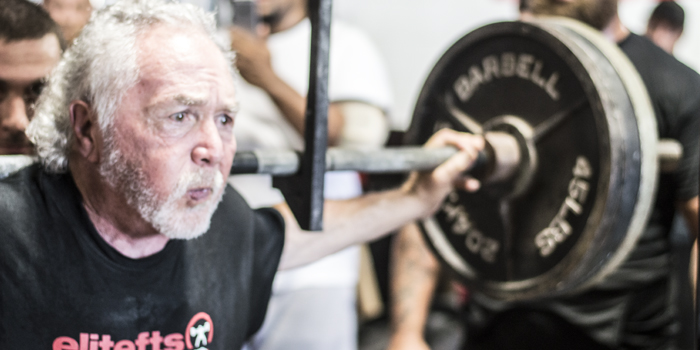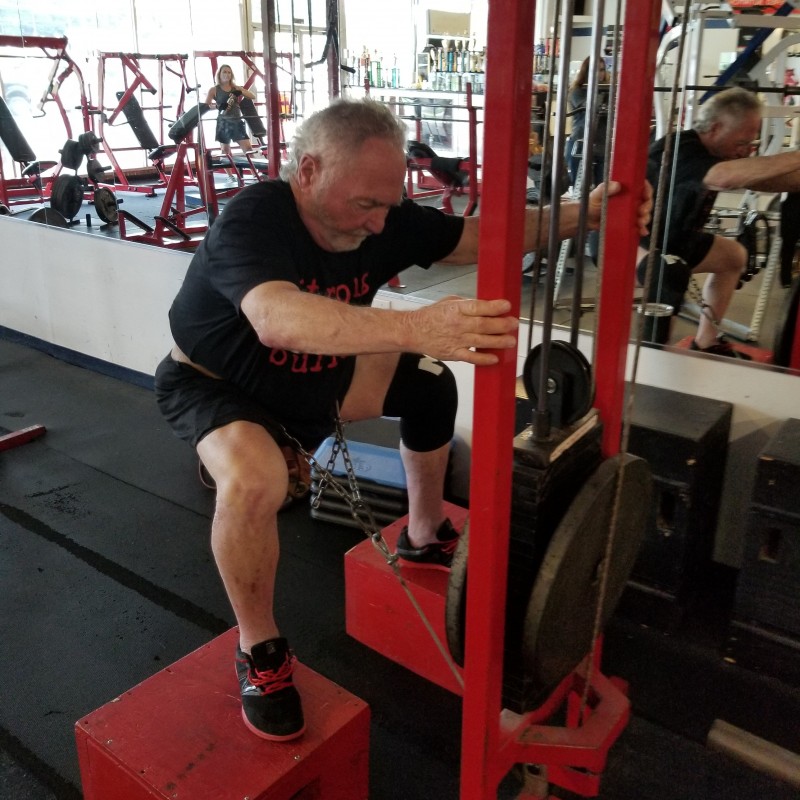
I have been asked on a few occasions to write about my specific training. I have not done that because I think readers would find it boring. Because I am not a sponsored athlete, I do not post my daily training logs.
While it might be boring to read about my specific training, I thought it might make sense to tell you about how I arrived at training as I do, my thought process, and my experience with the conjugate method. I do not consider it to be the be-all and end-all. I’m sure I will continue to evolve as I learn more and experience more. So, with sincere apologies to Louie Simmons, Dave Tate, and Nate Harvey, my gurus of the conjugate method, here we go.
I was introduced to powerlifting training by Donnie Thompson. I trained with him once a month for about two years. Because of the infrequency of our training, we only did max effort work. He had me squat for about two hours, then a few bench presses or deadlifts followed by kettlebells. I was so beaten up, my eyes were glazed over, and Donnie feared for me to drive home.
RECENT: Meet Report: A Squat Suit Depth Experiment at 365 Strong World Games
That became the only way I knew to train. I carried that mindset home and my training beat my ass. I never heard of things like deload, speed day, or off-season. As I often do with things that interest me, I began to read. I read articles online, bought books, and discovered articles on elitefts. Dave Tate’s articles on the three primary lifts were as instructive as anything I read. I entered meets and learned by watching and asking questions and getting advice. The most instructive and best thing I have done in powerlifting was becoming part of the elitefts team. In addition to meeting the best lifters in the country, I have learned from them at LTT seminars, individually, and from their articles, logs, and posts.
I read various programs and began to follow a program, which was a bastardization of what I had learned from Donnie, what I had read, and what I thought was best for me. I met and talked to Jim Wendler at an LTT seminar and listened to him speak, and eventually, bought some of his books. He is a compelling speaker and a very knowledgeable writer.
Soon, I was doing 5-3-1. In time, notwithstanding Wendler’s admonitions not to do it, I had modified it to suit my needs. I trained this way for a time and made quite satisfactory progress. I only trained three days a week and was making satisfactory progress but felt tired and beaten up. I didn’t know what to do, so I kept on keeping on. I had heard for a long time about the conjugate method employed first at Westside Barbell, and then around the country. I was not familiar with how it worked and whether or not it could work for me. I was satisfied with my adaptation of Wendler’s method.

Then, as I said in my article “I Read a Book,” I read Nate Harvey’s book about the conjugate system. It gave me the clearest understanding I have had on the system and erased some myths about it. I decided to try it, and try it I have. I will say that increasing training to four days a week troubled me. Not to worry; I felt better training four days than I did with three. That is because there are only two days of max-effort work rather than three. That is not to say that I don’t work hard on dynamic effort days. I do, but it is with lighter weights and more reps and not as overall taxing.
Conjugate involves much more variety in exercises than I have previously done. In fact, there are those who create new and interesting exercises every day. I am still old school. I have nothing against new exercises, as long as I can see that they improve or otherwise assist the three powerlifting lifts. I am still of the belief that if you want to squat heavy, then squat heavy. Too often I find myself resorting to old tried and true exercises.
OK, old man, you have taken us around the block; what the hell is it that you do?
I train four days a week. Because of my client schedule and domestic situation, those days are Monday through Thursday. Sometimes I take Wednesday off and train on Friday. The order in which one starts is irrelevant.
I try and space my max effort days as far apart as possible. I begin with a max effort bench. I try to use five different exercises for my main exercise. In addition to a straight bar, I use a fat bar, a football bar, pin presses, and floor presses. I alternate each week and shoot for a true max effort and PR on each.
LISTEN: Table Talk Podcast Clip — How Do I Get Stronger at 41 Years Old?
For accessory exercises, I generally do three of the following: close grip bench presses, dumbbell presses, pushdowns, pushdowns with bands, push-ups, or over-head triceps pulls.
One of the things on which I concentrate is speed with sub-maximal weight. It is a pet peeve of mine to see a 325-pound bencher move 200 pounds slowly. The same applies to the squat and deadlift. Then, I sip my lemonade and go home.
When I come to the gym, I like to have a chat with the owner and greet everyone I know. Once I start, I try not to bullshit and then get on with the training. I am, however, always available to spot or help someone.
Tuesday is dynamic effort lower body day. As of late, I have used this day to do as much back work as I can. My main lift has been wide-grip deadlifts with as much speed as I can. It’s helpful to both my legs and upper back and is a lift many lifters ignore. I am confident it carries over to both my bench and squat. I begin a better variety for my lower body like good mornings, Romanian Deadlifts, lunges, and box squats.
My accessory exercises are three of the following: chest-supported rows, dumbbell rows, bent-over rows, chest pulls, and face pulls.
Wednesday is dynamic upper body day. I use the same bar as I did for max effort day. When those bars involve a bench (i.e. fat bar, football bar, or straight bar), I wrap an elitefts Mini band around one end of the bar, then under the bench and around the other end of the bar. I then add an appropriate amount of weight so that I can do ten sets of three reps with the utmost speed.
Thereafter, my accessory exercises are the same choice as max effort day except that I use a lighter weight and do 12 to 15 reps.
On Thursday, when I make it that far, I do my max effort lower body day. Generally, I squat to a box with either a Safety Squat Bar or a BUFFALO BAR™. I do not often use a straight bar. I shoot for a max effort or PR with whatever bar I use. It takes a while and beats my ass. It’s like a day with Donnie.
As the weight gets heavier, I am fortunate to have guys in the gym to spot me and keep my old ass safe. To be honest, I don’t always have the energy to do accessories after a very heavy squat day. When I do, I do calf raises, kettlebell swings, Romanian Deadlifts, or good mornings.
Lately, I have been using a belt squat. I rigged up some equipment that allows me to squat with a belly, work on my depth, and ease the problem of using a heavy bar on my terrible shoulder. We call this redneck engineering. I was going to try to describe it in words, but it would take too long. I have enclosed a picture that shows what I have done and how it works. I’m sure it’s not new, but it’s new to me. My shoulder thanks me every time I use it.
Next week, I’ll see to what extent, if any, it carries over to my squat. With this device, I am able to do a great number of reps and sets and consequently, move a great deal of weight.
That is what I do for now. I am sure it will change in time, as I get older and wiser.











Thank you for this article, which is particularly interesting, not to mention helpful. I'm on the long side of 72 and still training, so it helps to see what others in our demographic are doing in terms of training. Despite aching backs, shoulders, and knees we train as much for the love of training as for our health. For some time now, I've believed there is a lack of useful information for and about strength training in the over-60 age demographic, especially the over-70 and beyond.
Again, thank you and please keep the articles coming.
Be well,
Joe